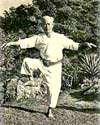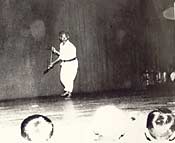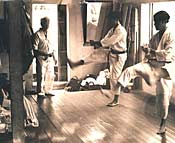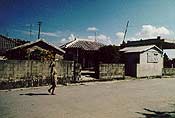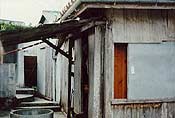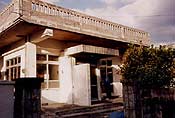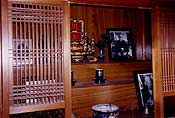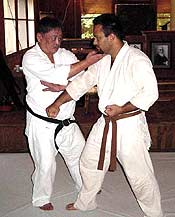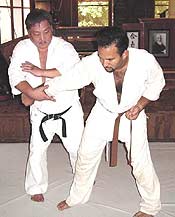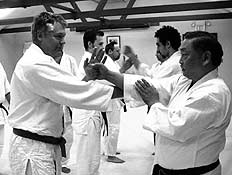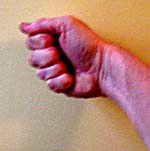I
Ippon Ken
Guest
Nabe (Tanme) Matsumura was Hohan Soken's teacher. He taught him the style known as Machimura Suidi. This is the original art of Sokon Matsumura before the advent of karate-do. Here is an Ernest Estrada interview with Soken in the 70's. If you've never read it before it may open some eyes. Here it is. Enjoy!
The following interview with Hohan Soken is by Ernest Estrada. We are very grateful to him for granting permission to us to use his work. SOKEN HOHAN (SHORIN-RYU)
The following interview was conducted at the Kadena NCO Club located at Kadena Air Base, Okinawa. Present were Soken Hohan and one of his senior students, Kise Fusei. Soken is a Shihan 10-Dan in Shorinryu Matsumura Seito Karate-do. His honbu dojo is located at 104 Gaja, Nishihara City, Okinawa Prefecture, Japan.
The date of the interview was September 10, 1978. The interview was conducted in Spanish . . . Soken spoke excellent Spanish due to the fact that he had lived in Argentina for over twenty-five years. I should also make mentioned that I was a Spanish language translator for the Pentagon for two plus years and worked in Washington, D.C., hence, I am familiar with the language.
Interviewer: Sensei, can you please identify yourself.
Soken-sensei: My name is Soken Hohan and I was born on May 25, 1889. I come from (I live in) Gaja Village, Nishihara City, Okinawa Prefecture. I am a native Okinawan. My style is officially called the Matsumura Orthodox Shorin-ryu Karate-do and I am a Shihan 10-Dan. My honbu dojo is presently located at Gaja Village, Nishihara City.
My style comes from Kayo Soken. To mark the occasion when Kayo was appointed the chief body-guard to King Sho Ko (and later to Sho Iku and then Sho Tai), he was allowed to change his name. This was a custom back then, especially if something important or notable happened to you; he changed his name to Matsumura, -- Matsumura Soken.
It was later that King Sho Tai officially gave Matsumura the title of "Bushi" { The term "bushi" is different from the Japanese meaning. In Japan a "bushi," in simplistic terms, is a warrior. In Okinawa, the term "bushi" also refers to the individual being a martial-man/warrior but with a strong slant to also being a true gentleman -- hence, the meaning, "a gentleman warrior." - ed} and to this day he is, with affection, referred to as Bushi Matsumura.
When Bushi Matsumura died he left the "hands" of his teachings to my uncle, who was his grandson, Matsumura Nabe. My mother was Nabe-tanmei's sister. Tanmei means "respected senior or respected old man," this was and still is a title of much respect in Okinawa. I became a student of my uncle around 1902 or 1903 and learned the original methods of Uchinan Sui-di, as it was then called.
Back then, there weren't large followings of students for a master of the warrior arts. Itosu Ankoh had less than a dozen students and he was one of the greatest of teachers at the time. My uncle had only one student, and that was me. He was still a practitioner with an "old mind" and would only teach or demonstrate for family members. Since I was the most interested, he allowed me to become his student.
I should also state that Matsumura Orthodox is not the only authentic shorin-ryu style. This style, my style, was passed on from Matsumura Sokon to my uncle, Nabe-tanmei but Nabe-tanmei was not Bushi Matsumura's only student. Matsumura had a good dozen or so dedicated students. Each one learned his methods and then expanded on them.
My uncle only learned from Bushi Matsumura and only taught me what he had learned. So, it can be said that it is an "old version" with no updates. By studying my Matsumura Orthodox you walk back into ancient times when karate was more forceful and challenging.
Interviewer: Sensei, can you tell me something about your training methods?
Sensei: Old training was always done in secret so that others would not steal your techniques. Nabe initially taught me stepping before anything. He would cut the leaves off the banana tree and place them on the ground. He would then have me do exercises to develop balance. If the balance was not good you would fall and since the exercises were always vigorous, a fall could seriously hurt you.
We would also use the pine trees that were found throughout Okinawa. We would slap or kick the trees and develop our gripping methods for close in fighting. This kind of training was very hard and severe on a person who had to work hard all day and then train hard at night. Life was very hard back then.
We would train twice a day. Early in the morning we would train on striking objects and conditioning to prepare one for the day. After working hard in the fields, we would have nightly training in two person techniques and conditioning like present-day kotekitai. We had to toughen our legs and hands - like iron, then they became true weapons. During the late hours we would practice the kata of Matsumura.
Interviewer: Can you tell me something about the kata you teach.
Sensei: Well, kata, yes, the most important Matsumura Seito kata is the kusanku. Sometimes we would practice the kusanku with kanzashi (hairpins) held in the hands - this was a common method of fighting. The hairpins were symbols of rank and many Okinawans carried them for decoration and also for protection.
Interviewer: I understand that you teach a white crane form. Is this the hakucho kata?
Sensei: No, hakucho, is another kata that, I believe, came from the Chinese tea seller, Go Kenki. He moved to Japan but my kata is much different. I call it hakutsuru. It was about... no, it was after ten years of training my uncle taught me the most secret kata of Matsumura Seito shorin-ryu, the hakutsuru (white crane) kata. This form stressed the balance -- all the Matsumura kata stressed balance but this form was the most dangerous in training.
The practice of the hakutsuru form forced me to learn better balance by performing the techniques while balanced on a pine log. Initially I learned the form on the ground and then I had to perform it on a log laying on the ground. For the advanced training the log was put into the river and tied down so as not to float away. I was then instructed to perform the kata while balanced on the log. It was very difficult and I almost drowned several times by falling and bouncing my head off the log.
Interviewer: You are recognized as a leading practitioner of traditional weaponry. Can you tell something about your weapons training?
Sensei: I studied traditional weaponry under Komesu Ushi-no-tanmei and later under Tsuken Mantaka. Tsuken is known for the bo form called Tsuken-nu-kun or Tsuken-bo. It is very famous.
Interviewer: Sensei, you speak excellent Spanish. Where did you learn to speak Spanish?
Sensei: Yes, Spanish. In 1924 I moved to Buenos Aires, Argentina, to find my fortune. I apprenticed myself as a photographer and later I worked in the clothes cleaning business. I learned Spanish there and I taught karate after they found out who I was. Most of my students in Argentina came from the Okinawan community - some Japanese.
All in all, in Argentina, I only had a small handful of students but we gave numerous demonstrations throughout the country. There were many, many Okinawans and Japanese living in Argentina. I returned to Okinawa in 1952.
Interviewer: What happened when you returned to Okinawa?
Sensei: I did not teach karate at first. Yes, not to the public but I began to teach a few family members which then opened up to a small dojo. I initially called it by the "hogen" name Machimura sui-de or in Japanese, Matsumura Shuri-te.
Around 1956 I changed the name of my teachings to Matsumura Orthodox Shorin-ryu karate-do. I still trained in the old ways and did not understand the new methods that were being taught. It appeared to be softer and more commercial. Because of this, I did not join the new organizations that were being formed at the time. My old way of karate was not readily accepted by everyone. They thought it too old and too crude -- I think it was just too hard or maybe my training methods were too severe. Whatever it was, it was the way I learned and the way I taught. It was later, when the Americans came to learn, that I changed my ways.
I found that there were two kinds of students - one was a dedicated and motivated student who wants to learn the Okinawan martial arts. The other is an individual who only wants to say he is learning karate. There are more of the latter. It is the latter that you see everywhere. They say that they "know" karate or that they "use to" practice karate - these are worthless individuals.
Interviewer: Can you tell me some more about your kata.
Sensei: I teach the Matsumura kata. The kata that I teach now are pinan shodan, pinan nidan, naihanchi shodan, naihanchi nidan, patsai-sho and dai, chinto, gojushiho, kusanku, rohai ichi-ni-san, and last, the hakutsuru. The last one is my favorite kata that I demonstrate - because it is easier to do. When I was young, the best kata was the kusanku. This is the Matsumura kusanku -- the older version that is not done much now.
I also teach bo, sai, tuifa, kama, nunchaku, kusarigama and suruchin. My favorite weapons form is tsukenbo (I learned that from Komesu Ushi) but in the old days it was the furi-gama or kusari-gama. We, on Okinawa, use a hand made rope to tie the kama to the hand or wrist. In Japan they use an iron chain but this is too cumbersome and can damage the student that practices that method.
I knew Taira Shinken very well before he died. I taught him some of my older forms. In 1970 I formed the All Okinawa Kobujutsu Association. I hope that this will spread all over the U.S. and mainland Japan. I am also a member of the Ryukyu Historical Society. We are trying to preserve the "hogen" dialect. Many young Okinawans no longer understand or even speak the old Okinawan language anymore. It is shameful.
[It should also be noted that Soken preferred to speak in his native dialect of Hogen. He often stated that he did not care for the Japanese language that much. -- Editor]
Interviewer: Sensei, you say that Shorin-ryu Matsumura Seito Karate-do is an old style with many secrets. Since you also say that you are getting old, what do you feel needs to be passed on to modem day students of Okinawan karate?
Sensei: There are many secrets in karate that people will never know and will never understand. These ideas are really not secret if you train in Okinawa under a good teacher. You will see the teacher use these so called secret techniques over and over again until they will become common knowledge to you. Others will look at it and marvel that it is an advanced or secret technique to them. That is because they do not have good teachers or their teachers have not researched their respective styles.
Karate is much more than simple punching and kicking and blocking. It is the study of weaponry and of grappling. Weaponry and empty hand fighting go together. How can you learn about defending against a weapon unless you are familiar with what the weapon can do?
[Soken-sensei used the Spanish word for wrestling when describing this art-form but I felt that a more apt term would be grappling - much like Japanese-style jujutsu. He stated that many people often referred to the Okinawan grappling arts as Okinawan-style wrestling mainly because it was never systematized and looked like a free-for-all form of fighting.
Soken-sensei continued by stating that as a youngster on Okinawa, that grappling was taken very seriously and it was not uncommon for individuals to suffer broken arms and legs as a result of taking part in this light form of entertainment. Soken-sensei would use the terms "te-kumi" or "gyaku-te" as identifying this old Okinawan art form.
The danger of reminding Soken-sensei of the "old methods of playing" was that he would often stand up, grab you, and then apply one of these painful methods of common people entertainment - he enjoyed watching Americans "squeaking like a mouse who had been stepped on." -- Editor]
Grappling is an old Okinawan custom that is commonly practiced in all villages. In America, the children played at "cowboys and indians. " In Okinawa we played by grappling with each other. We would have contests for grapplers in every village and one village would pit their best grapplers against all comers. It was very exciting.
Some people see the grappling and call it Okinawan jujutsu but this is incorrect. It is the old method called "ti." Ti { this is pronounced in the old dialect of Okinawa -- it sounds like the word "tea" -- ed. } practice was very common during the turn of the century but with the Japanese influences, these methods have almost disappear.
Interviewer: Sensei, any recommendations for us -- Americans?
Sensei: Yes, but you won't like it! Americans want to learn too much, too fast. You want more this and more that. You have a life time to learn. Learn slowly. Learn correctly. Look. Listen. Practice, practice, practice. Don't be a rash American, but a smart American. Never be in a hurry to learn, OK? Learning in a hurry can cause pain. Do you know about pain? Let me show you!
DEMONSTRATION: At this time, Soken demonstrated basic "ti" methods involving the use of the "sharp forearm bone" and the "thumbing" methods. All of them hurt - a lot! He had an uncanny command of the human anatomy and would use the thumb to hit the various nerves in the shoulder, the forearm and the sides of the body. He laughed a lot when doing this - he really enjoyed grappling.
A number of techniques resembled aikiJutsu movements and instead of moving in on the opponent, he would step backwards and would use his body weight to increase the power of the technique. He would always block using what he called a "double bone block" and counter with a thumb technique or a grappling technique that took you to the ground.
Soken stated that he could drive an individual through the ground or just simply throw him on the ground either way, the opponent was at a distinct disadvantage. He could then subdue you with techniques like kicks or move away from the confrontation.
Taken from the second interview:
Interviewer: Sensei, your kata is very distinct and beautiful to see. I have a question that has been bothering me since the Okinawan Expo. Remember when we saw the bo fighters in Nago. They used the names of many of the kata that are practiced today but they are very different. The only thing that appears to be the same is the name.
Sensei: Yes, they are the same and they are not the same. You say you lived on Okinawa for five years but you cannot understand the Okinawan people. In the old days, when we were really Okinawan and not Japanese, many of the old people were not smart -- or as smart as they are today. They did not travel, they did not watch TV, many never left their villages unless they had to. What we did have was festivals... village festivals. Everyone would come and watch and learn.
These village people would watch the other fancy city people practice their ti or their methods of weaponry. Say, like... well, ... Yes, a kata that they knew or practice had a number of movements. They come to the city and see and city kata with some of the same movements. The city kata had a name... and maybe their kata did not have a name. So, they would go back and ... yes, you now understand. They would name their kata after the city kata because they had a few of the same movements.
Some of their kata had five or maybe ten movements. Taira, my friend, would go to the village and learn these kata. He says that he learned 500 kata this way! Wah! This is true but he also liked to tell stories. Some of these kata had only 3 or maybe 5 movements. 500 kata, yes, now that is funny but he was a history collector. He knew them but he didnt understand them.
Interviewer: Was Taira a friend or student? He is very famous for his weaponry in Japan.
Sensei: Yes, Taira... he knew a lot of kata, huh. Huh, huh, huh... Yes, he is dead, you know that. He would watch my kata all the time and try to learn my tsuken style stick. But I would trick him and change the kata, wah!! ... just like that. He would still come back and look some more in the hopes of being able to take it back. When we both were young -- our karate was very good. When we both got old, our weaponry was good.
Why do you want to know these things -- these old ideas, these old ways. Their old value was to survive a challenge match. You punch me and I will show you ... good karate means you also test yourself through pain. Like pain... in good karate... movements are quick, like a mongoose. If you are slow, you can die. If you are quick, then there is a chance that you and your family (???) will live.
Interviewer: Yes, fighting must have been very different at the beginning of this century.
Sensei: Yes, you don't know these old days. In a fight... if you would lose, the loss would be suffered by your family. They could die. You would work hard to support the family working all day, If you were injured or killed while fighting, then your family would starve... maybe even die. Okinawa life was very hard.
Now, the young people want to be Japanese. They don't speak the Okinawan language. They are lazy. They do not respect old people, they have no pride in being Okinawan. Yes, we are a poor country but that is no excuse in putting our culture in the dark and saying we are someone that we are not. This is no good.
NOTE: The second interview ends here. Sensei's mind begins to wander and he begins to get angry. I believe it has to do with painful, old memories that are brought up by the questions. setstats 1
The following interview with Hohan Soken is by Ernest Estrada. We are very grateful to him for granting permission to us to use his work. SOKEN HOHAN (SHORIN-RYU)
The following interview was conducted at the Kadena NCO Club located at Kadena Air Base, Okinawa. Present were Soken Hohan and one of his senior students, Kise Fusei. Soken is a Shihan 10-Dan in Shorinryu Matsumura Seito Karate-do. His honbu dojo is located at 104 Gaja, Nishihara City, Okinawa Prefecture, Japan.
The date of the interview was September 10, 1978. The interview was conducted in Spanish . . . Soken spoke excellent Spanish due to the fact that he had lived in Argentina for over twenty-five years. I should also make mentioned that I was a Spanish language translator for the Pentagon for two plus years and worked in Washington, D.C., hence, I am familiar with the language.
Interviewer: Sensei, can you please identify yourself.
Soken-sensei: My name is Soken Hohan and I was born on May 25, 1889. I come from (I live in) Gaja Village, Nishihara City, Okinawa Prefecture. I am a native Okinawan. My style is officially called the Matsumura Orthodox Shorin-ryu Karate-do and I am a Shihan 10-Dan. My honbu dojo is presently located at Gaja Village, Nishihara City.
My style comes from Kayo Soken. To mark the occasion when Kayo was appointed the chief body-guard to King Sho Ko (and later to Sho Iku and then Sho Tai), he was allowed to change his name. This was a custom back then, especially if something important or notable happened to you; he changed his name to Matsumura, -- Matsumura Soken.
It was later that King Sho Tai officially gave Matsumura the title of "Bushi" { The term "bushi" is different from the Japanese meaning. In Japan a "bushi," in simplistic terms, is a warrior. In Okinawa, the term "bushi" also refers to the individual being a martial-man/warrior but with a strong slant to also being a true gentleman -- hence, the meaning, "a gentleman warrior." - ed} and to this day he is, with affection, referred to as Bushi Matsumura.
When Bushi Matsumura died he left the "hands" of his teachings to my uncle, who was his grandson, Matsumura Nabe. My mother was Nabe-tanmei's sister. Tanmei means "respected senior or respected old man," this was and still is a title of much respect in Okinawa. I became a student of my uncle around 1902 or 1903 and learned the original methods of Uchinan Sui-di, as it was then called.
Back then, there weren't large followings of students for a master of the warrior arts. Itosu Ankoh had less than a dozen students and he was one of the greatest of teachers at the time. My uncle had only one student, and that was me. He was still a practitioner with an "old mind" and would only teach or demonstrate for family members. Since I was the most interested, he allowed me to become his student.
I should also state that Matsumura Orthodox is not the only authentic shorin-ryu style. This style, my style, was passed on from Matsumura Sokon to my uncle, Nabe-tanmei but Nabe-tanmei was not Bushi Matsumura's only student. Matsumura had a good dozen or so dedicated students. Each one learned his methods and then expanded on them.
My uncle only learned from Bushi Matsumura and only taught me what he had learned. So, it can be said that it is an "old version" with no updates. By studying my Matsumura Orthodox you walk back into ancient times when karate was more forceful and challenging.
Interviewer: Sensei, can you tell me something about your training methods?
Sensei: Old training was always done in secret so that others would not steal your techniques. Nabe initially taught me stepping before anything. He would cut the leaves off the banana tree and place them on the ground. He would then have me do exercises to develop balance. If the balance was not good you would fall and since the exercises were always vigorous, a fall could seriously hurt you.
We would also use the pine trees that were found throughout Okinawa. We would slap or kick the trees and develop our gripping methods for close in fighting. This kind of training was very hard and severe on a person who had to work hard all day and then train hard at night. Life was very hard back then.
We would train twice a day. Early in the morning we would train on striking objects and conditioning to prepare one for the day. After working hard in the fields, we would have nightly training in two person techniques and conditioning like present-day kotekitai. We had to toughen our legs and hands - like iron, then they became true weapons. During the late hours we would practice the kata of Matsumura.
Interviewer: Can you tell me something about the kata you teach.
Sensei: Well, kata, yes, the most important Matsumura Seito kata is the kusanku. Sometimes we would practice the kusanku with kanzashi (hairpins) held in the hands - this was a common method of fighting. The hairpins were symbols of rank and many Okinawans carried them for decoration and also for protection.
Interviewer: I understand that you teach a white crane form. Is this the hakucho kata?
Sensei: No, hakucho, is another kata that, I believe, came from the Chinese tea seller, Go Kenki. He moved to Japan but my kata is much different. I call it hakutsuru. It was about... no, it was after ten years of training my uncle taught me the most secret kata of Matsumura Seito shorin-ryu, the hakutsuru (white crane) kata. This form stressed the balance -- all the Matsumura kata stressed balance but this form was the most dangerous in training.
The practice of the hakutsuru form forced me to learn better balance by performing the techniques while balanced on a pine log. Initially I learned the form on the ground and then I had to perform it on a log laying on the ground. For the advanced training the log was put into the river and tied down so as not to float away. I was then instructed to perform the kata while balanced on the log. It was very difficult and I almost drowned several times by falling and bouncing my head off the log.
Interviewer: You are recognized as a leading practitioner of traditional weaponry. Can you tell something about your weapons training?
Sensei: I studied traditional weaponry under Komesu Ushi-no-tanmei and later under Tsuken Mantaka. Tsuken is known for the bo form called Tsuken-nu-kun or Tsuken-bo. It is very famous.
Interviewer: Sensei, you speak excellent Spanish. Where did you learn to speak Spanish?
Sensei: Yes, Spanish. In 1924 I moved to Buenos Aires, Argentina, to find my fortune. I apprenticed myself as a photographer and later I worked in the clothes cleaning business. I learned Spanish there and I taught karate after they found out who I was. Most of my students in Argentina came from the Okinawan community - some Japanese.
All in all, in Argentina, I only had a small handful of students but we gave numerous demonstrations throughout the country. There were many, many Okinawans and Japanese living in Argentina. I returned to Okinawa in 1952.
Interviewer: What happened when you returned to Okinawa?
Sensei: I did not teach karate at first. Yes, not to the public but I began to teach a few family members which then opened up to a small dojo. I initially called it by the "hogen" name Machimura sui-de or in Japanese, Matsumura Shuri-te.
Around 1956 I changed the name of my teachings to Matsumura Orthodox Shorin-ryu karate-do. I still trained in the old ways and did not understand the new methods that were being taught. It appeared to be softer and more commercial. Because of this, I did not join the new organizations that were being formed at the time. My old way of karate was not readily accepted by everyone. They thought it too old and too crude -- I think it was just too hard or maybe my training methods were too severe. Whatever it was, it was the way I learned and the way I taught. It was later, when the Americans came to learn, that I changed my ways.
I found that there were two kinds of students - one was a dedicated and motivated student who wants to learn the Okinawan martial arts. The other is an individual who only wants to say he is learning karate. There are more of the latter. It is the latter that you see everywhere. They say that they "know" karate or that they "use to" practice karate - these are worthless individuals.
Interviewer: Can you tell me some more about your kata.
Sensei: I teach the Matsumura kata. The kata that I teach now are pinan shodan, pinan nidan, naihanchi shodan, naihanchi nidan, patsai-sho and dai, chinto, gojushiho, kusanku, rohai ichi-ni-san, and last, the hakutsuru. The last one is my favorite kata that I demonstrate - because it is easier to do. When I was young, the best kata was the kusanku. This is the Matsumura kusanku -- the older version that is not done much now.
I also teach bo, sai, tuifa, kama, nunchaku, kusarigama and suruchin. My favorite weapons form is tsukenbo (I learned that from Komesu Ushi) but in the old days it was the furi-gama or kusari-gama. We, on Okinawa, use a hand made rope to tie the kama to the hand or wrist. In Japan they use an iron chain but this is too cumbersome and can damage the student that practices that method.
I knew Taira Shinken very well before he died. I taught him some of my older forms. In 1970 I formed the All Okinawa Kobujutsu Association. I hope that this will spread all over the U.S. and mainland Japan. I am also a member of the Ryukyu Historical Society. We are trying to preserve the "hogen" dialect. Many young Okinawans no longer understand or even speak the old Okinawan language anymore. It is shameful.
[It should also be noted that Soken preferred to speak in his native dialect of Hogen. He often stated that he did not care for the Japanese language that much. -- Editor]
Interviewer: Sensei, you say that Shorin-ryu Matsumura Seito Karate-do is an old style with many secrets. Since you also say that you are getting old, what do you feel needs to be passed on to modem day students of Okinawan karate?
Sensei: There are many secrets in karate that people will never know and will never understand. These ideas are really not secret if you train in Okinawa under a good teacher. You will see the teacher use these so called secret techniques over and over again until they will become common knowledge to you. Others will look at it and marvel that it is an advanced or secret technique to them. That is because they do not have good teachers or their teachers have not researched their respective styles.
Karate is much more than simple punching and kicking and blocking. It is the study of weaponry and of grappling. Weaponry and empty hand fighting go together. How can you learn about defending against a weapon unless you are familiar with what the weapon can do?
[Soken-sensei used the Spanish word for wrestling when describing this art-form but I felt that a more apt term would be grappling - much like Japanese-style jujutsu. He stated that many people often referred to the Okinawan grappling arts as Okinawan-style wrestling mainly because it was never systematized and looked like a free-for-all form of fighting.
Soken-sensei continued by stating that as a youngster on Okinawa, that grappling was taken very seriously and it was not uncommon for individuals to suffer broken arms and legs as a result of taking part in this light form of entertainment. Soken-sensei would use the terms "te-kumi" or "gyaku-te" as identifying this old Okinawan art form.
The danger of reminding Soken-sensei of the "old methods of playing" was that he would often stand up, grab you, and then apply one of these painful methods of common people entertainment - he enjoyed watching Americans "squeaking like a mouse who had been stepped on." -- Editor]
Grappling is an old Okinawan custom that is commonly practiced in all villages. In America, the children played at "cowboys and indians. " In Okinawa we played by grappling with each other. We would have contests for grapplers in every village and one village would pit their best grapplers against all comers. It was very exciting.
Some people see the grappling and call it Okinawan jujutsu but this is incorrect. It is the old method called "ti." Ti { this is pronounced in the old dialect of Okinawa -- it sounds like the word "tea" -- ed. } practice was very common during the turn of the century but with the Japanese influences, these methods have almost disappear.
Interviewer: Sensei, any recommendations for us -- Americans?
Sensei: Yes, but you won't like it! Americans want to learn too much, too fast. You want more this and more that. You have a life time to learn. Learn slowly. Learn correctly. Look. Listen. Practice, practice, practice. Don't be a rash American, but a smart American. Never be in a hurry to learn, OK? Learning in a hurry can cause pain. Do you know about pain? Let me show you!
DEMONSTRATION: At this time, Soken demonstrated basic "ti" methods involving the use of the "sharp forearm bone" and the "thumbing" methods. All of them hurt - a lot! He had an uncanny command of the human anatomy and would use the thumb to hit the various nerves in the shoulder, the forearm and the sides of the body. He laughed a lot when doing this - he really enjoyed grappling.
A number of techniques resembled aikiJutsu movements and instead of moving in on the opponent, he would step backwards and would use his body weight to increase the power of the technique. He would always block using what he called a "double bone block" and counter with a thumb technique or a grappling technique that took you to the ground.
Soken stated that he could drive an individual through the ground or just simply throw him on the ground either way, the opponent was at a distinct disadvantage. He could then subdue you with techniques like kicks or move away from the confrontation.
Taken from the second interview:
Interviewer: Sensei, your kata is very distinct and beautiful to see. I have a question that has been bothering me since the Okinawan Expo. Remember when we saw the bo fighters in Nago. They used the names of many of the kata that are practiced today but they are very different. The only thing that appears to be the same is the name.
Sensei: Yes, they are the same and they are not the same. You say you lived on Okinawa for five years but you cannot understand the Okinawan people. In the old days, when we were really Okinawan and not Japanese, many of the old people were not smart -- or as smart as they are today. They did not travel, they did not watch TV, many never left their villages unless they had to. What we did have was festivals... village festivals. Everyone would come and watch and learn.
These village people would watch the other fancy city people practice their ti or their methods of weaponry. Say, like... well, ... Yes, a kata that they knew or practice had a number of movements. They come to the city and see and city kata with some of the same movements. The city kata had a name... and maybe their kata did not have a name. So, they would go back and ... yes, you now understand. They would name their kata after the city kata because they had a few of the same movements.
Some of their kata had five or maybe ten movements. Taira, my friend, would go to the village and learn these kata. He says that he learned 500 kata this way! Wah! This is true but he also liked to tell stories. Some of these kata had only 3 or maybe 5 movements. 500 kata, yes, now that is funny but he was a history collector. He knew them but he didnt understand them.
Interviewer: Was Taira a friend or student? He is very famous for his weaponry in Japan.
Sensei: Yes, Taira... he knew a lot of kata, huh. Huh, huh, huh... Yes, he is dead, you know that. He would watch my kata all the time and try to learn my tsuken style stick. But I would trick him and change the kata, wah!! ... just like that. He would still come back and look some more in the hopes of being able to take it back. When we both were young -- our karate was very good. When we both got old, our weaponry was good.
Why do you want to know these things -- these old ideas, these old ways. Their old value was to survive a challenge match. You punch me and I will show you ... good karate means you also test yourself through pain. Like pain... in good karate... movements are quick, like a mongoose. If you are slow, you can die. If you are quick, then there is a chance that you and your family (???) will live.
Interviewer: Yes, fighting must have been very different at the beginning of this century.
Sensei: Yes, you don't know these old days. In a fight... if you would lose, the loss would be suffered by your family. They could die. You would work hard to support the family working all day, If you were injured or killed while fighting, then your family would starve... maybe even die. Okinawa life was very hard.
Now, the young people want to be Japanese. They don't speak the Okinawan language. They are lazy. They do not respect old people, they have no pride in being Okinawan. Yes, we are a poor country but that is no excuse in putting our culture in the dark and saying we are someone that we are not. This is no good.
NOTE: The second interview ends here. Sensei's mind begins to wander and he begins to get angry. I believe it has to do with painful, old memories that are brought up by the questions. setstats 1

